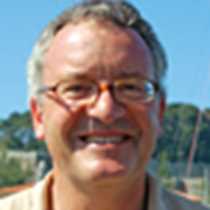Alexandria
Having sailed east to west across the mouth of the Nile delta overnight, the Alexandria pilot boarded the ship an hour before breakfast as we made our approach into one of the world's historic harbors. This grid-pattern maritime city, founded by Alexander the Great in 332BC, was an extension of the Hellenistic world. With its library, museum and famous schools, Alexandria became one of the great centers of learning of the ancient world, a cosmopolitan city where a number of different cultural traditions came together to produce more than the sum of their respective parts.
An excellent example of the latter was to be seen at the Catacombs, our first stop on the morning tour, where the artwork on the sarcophagi was an interesting amalgam of Pharaonic and Hellenistic elements, the goddess Isis, her wings outstretched to symbolize resurrection, being draped in a toga. The Catacombs were discovered in 1900 when a passing mule fell into a deep chamber but only in the late twentieth century were they made safe for visitors. A collection of bones in the hall of Caracalla, once presumed to have been those of Christians martyred in the persecutions he initiated, have recently been identified as belonging to a deceased horse.
It is claimed that Christianity was introduced to Africa by St Mark who proclaimed the gospel for the first time on that continent at Alexandria in AD60. Some twelve per cent of the population today is Coptic Christian and we saw their cathedral as we progressed along the impressive Corniche, the long coastal promenade on which such other sights as the Cecil Hotel are situated. We visited the site of the former lighthouse on the island of Pharos; in its day had been one of the wonders of the ancient world. Likewise the famous library of which no trace remains above ground but our afternoon visit was to its impressive successor, a Unesco funded library designed by a joint Egyptian-Norwegian syndicate and opened in 2002. It is high-tech and well used and offers hope for the continuance of a tradition of learning for which the city has been famed for over two thousand years.
Back on board, after dinner, we were privileged to have a presentation by Dr. Harry Tzalas who is currently carrying out marine archaeological investigations just off the city's shoreline. It is rewarding work, he explained, but difficult: the port is exposed to prevailing northerly winds and high seas were a frequent occurrence.
Having sailed east to west across the mouth of the Nile delta overnight, the Alexandria pilot boarded the ship an hour before breakfast as we made our approach into one of the world's historic harbors. This grid-pattern maritime city, founded by Alexander the Great in 332BC, was an extension of the Hellenistic world. With its library, museum and famous schools, Alexandria became one of the great centers of learning of the ancient world, a cosmopolitan city where a number of different cultural traditions came together to produce more than the sum of their respective parts.
An excellent example of the latter was to be seen at the Catacombs, our first stop on the morning tour, where the artwork on the sarcophagi was an interesting amalgam of Pharaonic and Hellenistic elements, the goddess Isis, her wings outstretched to symbolize resurrection, being draped in a toga. The Catacombs were discovered in 1900 when a passing mule fell into a deep chamber but only in the late twentieth century were they made safe for visitors. A collection of bones in the hall of Caracalla, once presumed to have been those of Christians martyred in the persecutions he initiated, have recently been identified as belonging to a deceased horse.
It is claimed that Christianity was introduced to Africa by St Mark who proclaimed the gospel for the first time on that continent at Alexandria in AD60. Some twelve per cent of the population today is Coptic Christian and we saw their cathedral as we progressed along the impressive Corniche, the long coastal promenade on which such other sights as the Cecil Hotel are situated. We visited the site of the former lighthouse on the island of Pharos; in its day had been one of the wonders of the ancient world. Likewise the famous library of which no trace remains above ground but our afternoon visit was to its impressive successor, a Unesco funded library designed by a joint Egyptian-Norwegian syndicate and opened in 2002. It is high-tech and well used and offers hope for the continuance of a tradition of learning for which the city has been famed for over two thousand years.
Back on board, after dinner, we were privileged to have a presentation by Dr. Harry Tzalas who is currently carrying out marine archaeological investigations just off the city's shoreline. It is rewarding work, he explained, but difficult: the port is exposed to prevailing northerly winds and high seas were a frequent occurrence.



